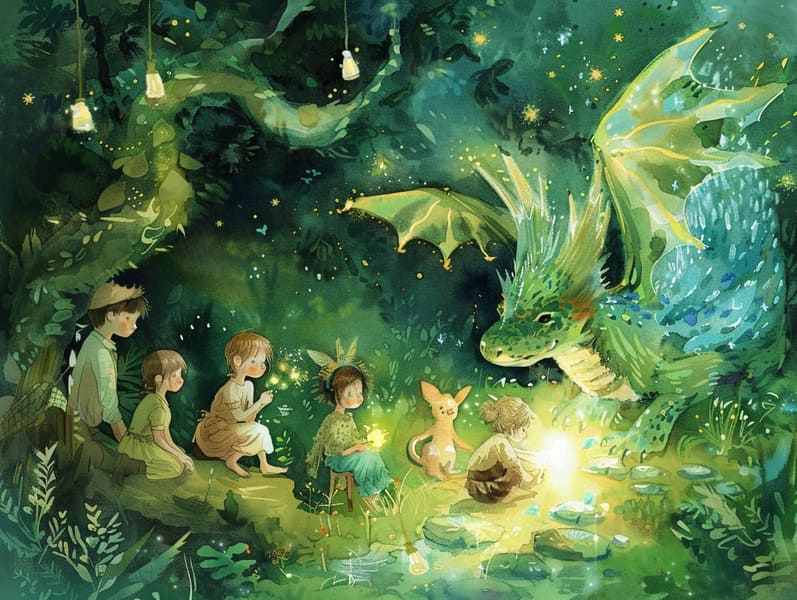The Inception of Old Fairy Tales with Their Invariable Beauty.
The Inception of Old Fairy Tales with Their Invariable Beauty.
Blog Article

Fairy tales for kids have ancient roots. These narratives have been told from one generation to the next well before they were ever recorded. They sprang from a variety of civilizations, including Eastern traditions. They were initially told among older generations, often carrying themes and messages relevant to the societal norms and beliefs of the time.
Jacob and Wilhelm Grimm, Jacob and Wilhelm Grimm, were among the first to gather and publish many of these beloved narratives. Their published works, "Grimm's Fairy Tales," included stories like "The Little Glass Slipper," "Little Brother and Little Sister," and "The True Story of Snow White," which have since become staples in the world of classic fairy tales. Similarly, Hans Christian Andersen's magical fairy tales, such as "The Story of the Little Mermaid," and "The Duckling that Could," have enchanted hearts worldwide, securing their place in the pantheon of classic fairy tales.
Despite their ancient origins, fairy tales remain as meaningful as ever, especially as nighttime stories for kids. These whimsical stories are now available in diverse formats, including gorgeously illustrated books, magical animations, and online fairy tales.
Their lasting presence can be linked to several enchanting factors:
Moral Lessons: Classic fairy tales often offer important moral lessons. Fairy tales like "The Boy Who Cried Wolf" teach the virtue of being truthful, while "The Hare and the Tortoise" emphasize the virtues of determination and humbleness. These tales offer little ones clear distinctions between good and bad, building their moral compass in a kind yet profound way.
Kindness and Comprehension: Ancient fairy tales frequently illustrate heroes facing problems and hurdles, inspiring children to empathize with their struggles and encourage their triumphs. For instance, "Beauty and the Beast" points out the importance of looking deeper to realize the inner spirit of a character, encouraging empathy and knowledge.
Cultural Perception: Many classic fairy tales are steeped in the cultural contexts from which they emerged. Immersing in these fairy tales can provide delightful insights into different ways of life, advancing a sense of global insight and appreciation.
Creativity and Fantasy: The enchanted elements in old fairy tales—spells and potions—trigger children’s creativity. These stories lead readers to mythical realms, boosting inventive thinking and a sense of enchantment that stays a lifetime.
Old fairy tales are not only fantastical but also teaching. They act as charming tools in promoting various intellectual and emotional capacities in the young. When old fairy tales are narrated, they foster language skills by introducing new terms and complex sentence structures. This practice also fosters hearing perception and concentration, as young readers track the narrative, keen to see what happens next.
Furthermore, reflecting on the themes and characters of traditional fairy tales can sharpen intellectual skills and problem-solving abilities. Kids are shown to find patterns, make predictions, and grasp cause and effect. These examinations also advance kids verbalize their thoughts and feelings, cultivating their emotional intelligence.
In today’s technological age, the existence of digital storybooks has made these narratives more accessible than ever. Internet resources and mobile apps offer comprehensive collections of timeless fairy tales that can be browsed or listened through anytime, anywhere. Fairy tales read out loud are particularly prevalent, presenting an immersive method for the young to take part in these charming stories. Read-aloud stories and spoken videos bring characters and settings to life, often complemented by spellbinding sound effects and harmonies that raise the story adventure.
The enduring charm of ancient fairy tales lies in their ability to shift to present eras while sustaining their basic principles. Contemporary retellings of these fairy tales often integrate more representative characters and modern settings, making them accessible to today’s audience. However, the central morals of fearlessness, kindness, and truth remain unchanged, continuing to resonate with children of all ages.
Fairy tales also offer a sense of familiarity and comprehensibility. They afford a orderly narrative with a recognizable beginning, middle, and end, often ending with the ending of conflicts and the triumph of truth over falsehood. This certainty can be placating for children, introducing a sense of steadfastness in an unpredictable world.
Timeless fairy tales continue to captivate and inform new generations, maintaining their spell and value in modern society. As bedtime stories for kids, they deliver up a perfect blend of charm and understanding, boosting moral values, empathy, and creativity. The accessibility of free fairy tales online and the favor of fairy tales read aloud validate that these traditional fairy tales remain within reach to new generations.
By keeping and passing on these stories, we continue to cherish the here rich tapestry of creativity and cultural heritage. Whether you are exploring a artistically illustrated book, discovering a digital library, or listening to an spoken story, the allure of bedtime fairy tales is always within reach. These tales teach us of the enduring strength of narratives and its ability to gather us across centuries and lands.
Even if you are seeing a richly illustrated book, perusing a electronic collection, or listening via an read-aloud story, the grace of Grimm's fairy tales is always within reach.
These fairy tales reveal of the ageless force of stories and its ability to gather us across epochs and places, casting a charm that delights and instructs alike.